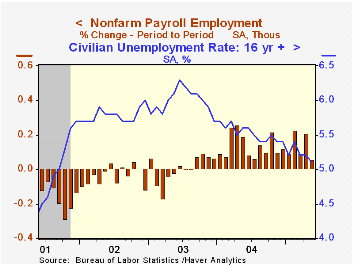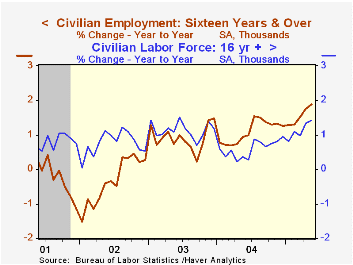 Global| Jun 03 2005
Global| Jun 03 2005U.S. Job Gain Well Short of Expectations
by:Tom Moeller
|in:Economy in Brief
Summary
Non-farm payrolls increased just 78,000 in May, the weakest rise since 2003. The prior month's strong gain was revised slightly higher but March was revised lower. Consensus expectations had been for a 180,000 May increase. Widespread [...]

Non-farm payrolls increased just 78,000 in May, the weakest rise since 2003. The prior month's strong gain was revised slightly higher but March was revised lower. Consensus expectations had been for a 180,000 May increase.
Widespread declines in private service producing industries where payrolls rose 59,000 (1.9% y/y) last month accounted for the weakness. Information services jobs fell 8,000 (-0.2% y/y), real estate & leasing jobs were off 1,700 (+2.4% y/y), temporary services jobs fell 4,300 (+5.3% y/y) and jobs in leisure industries fell 6,000 (+2.0% y/y).
Factory sector payrolls fell 7,000 for the fourth monthly decline this year. A 10,000 worker decline in nondurable goods industries (-1.5% y/y) centered in the apparel and the paper industries.
Construction jobs rose 20,000 (4.0% y/y) but that was less than half the prior month's increase. Total government employment rose a modest 5,000 (0.8% y/y). Federal government jobs increased 1,000 (-0.4% y/y) and local gov't employment rose 5,000 (0.8% y/y). 
The household survey indicated that the unemployment rate fell unexpectedly to 5.1%, the lowest level since 2001. Employment again was strong posting a 376,000 (1.9% y/y) rise and the labor force rose 360,000 (1.4% y/y). The labor force participation rate moved higher for the second month to 66.1% as the number of dropouts from the force fell for the second month. Growth in dropouts fell to 0.8% y/y, down from the high of 3.7% late in 2003.
The index of aggregate hours worked (employment times hours worked) rose a slight 0.1% (2.3% y/y) and the gain in April was scaled back to 0.6% due to a downward revision to the length of the workweek. The level of hours worked so far in 2Q is up 3.4% (AR) from 1Q05.
The increase in average hourly earnings slowed to 0.2% though earnings in manufacturing rose a strong 0.4% (2.7% y/y).
What's Driving Wage Inequality? The Effects of Technical Change on the Labor Market from the Federal Reserve Bank of Richmond can be found here.
| Employment | May | April | Y/Y | 2004 | 2003 | 2002 |
|---|---|---|---|---|---|---|
| Payroll Employment | 78,000 | 274,000 | 1.5% | 1.1% | -0.3% | -1.1% |
| Manufacturing | -7,000 | -9,000 | -0.3% | -1.2% | -4.9% | -7.2% |
| Average Weekly Hours | 33.8 | 33.8 | 33.8 | 33.7 | 33.7 | 33.8 |
| Average Hourly Earnings | 0.2% | 0.3% | 2.6% | 2.1% | 2.7% | 2.9% |
| Unemployment Rate | 5.1% | 5.2% | 5.6% | 5.5% | 6.0% | 5.8% |
Tom Moeller
AuthorMore in Author Profile »Prior to joining Haver Analytics in 2000, Mr. Moeller worked as the Economist at Chancellor Capital Management from 1985 to 1999. There, he developed comprehensive economic forecasts and interpreted economic data for equity and fixed income portfolio managers. Also at Chancellor, Mr. Moeller worked as an equity analyst and was responsible for researching and rating companies in the economically sensitive automobile and housing industries for investment in Chancellor’s equity portfolio. Prior to joining Chancellor, Mr. Moeller was an Economist at Citibank from 1979 to 1984. He also analyzed pricing behavior in the metals industry for the Council on Wage and Price Stability in Washington, D.C. In 1999, Mr. Moeller received the award for most accurate forecast from the Forecasters' Club of New York. From 1990 to 1992 he was President of the New York Association for Business Economists. Mr. Moeller earned an M.B.A. in Finance from Fordham University, where he graduated in 1987. He holds a Bachelor of Arts in Economics from George Washington University.






